基于潜在概念学习、隐马尔可夫模型和主题建模的多阶段无监督威胁检测
IF 3.7
2区 计算机科学
Q2 COMPUTER SCIENCE, INFORMATION SYSTEMS
Journal of Information Security and Applications
Pub Date : 2025-07-10
DOI:10.1016/j.jisa.2025.104160
引用次数: 0
摘要
由于标记攻击数据的稀缺性、不平衡数据集的存在以及现代对手的复杂性,在大规模系统日志中检测横向移动威胁是一项关键挑战。为了解决这些问题,我们提出了ConceptUML,这是一个语义驱动的、完全无监督的威胁检测框架,旨在自动识别与异构日志数据中横向移动相关的异常。ConceptUML是围绕一个三阶段架构构建的。在阶段1(潜在语义学习)中,将由句子bert生成的上下文化嵌入与非负矩阵分解相结合,从系统日志和外部威胁情报源(如MITRE att&ck和CAPEC)中提取抽象概念。在第二阶段(无监督威胁检测)中,基于学习到的概念将隐马尔可夫模型应用于聚类日志,并根据其与已知对抗技术的语义相似度对每个聚类进行评分。阶段3(决策细化)使用主题建模进一步从可疑集群中隔离恶意事件日志子集,从而实现高精度分类。我们使用四个真实世界的事件日志数据集来评估ConceptUML,包括Windows事件日志和LMD-23数据集的多个子集,包括利用哈希技术和远程服务的攻击。使用主题建模的增强模型实现了高达92.54%的检测质量,并将检测误差降低到8.14%,优于AutoEncoder, LogAnomaly, LOF和DBScan等几种基准方法。我们的研究结果证实,ConceptUML提供了可解释的、可扩展的、高效的横向移动威胁检测,而不需要标记训练数据或大量的人工特征工程。本文章由计算机程序翻译,如有差异,请以英文原文为准。
ConceptUML: Multiphase unsupervised threat detection via latent concept learning, Hidden Markov Models and topic modelling
Detecting lateral movement threats in large-scale system logs is a critical challenge due to the scarcity of labelled attack data, the presence of imbalanced datasets, and the sophisticated nature of modern adversaries. To address these issues, we propose ConceptUML, a semantic-driven, fully unsupervised threat detection framework designed to automatically identify anomalies related to lateral movement in heterogeneous log data. ConceptUML is structured around a three-phase architecture. In Phase 1 (Latent Semantic Learning), contextualized embeddings generated by Sentence-BERT are combined with Non-negative Matrix Factorization to extract abstract concepts from system logs and external threat intelligence sources such as MITRE ATT&CK and CAPEC. In Phase 2 (Unsupervised Threat Detection), a Hidden Markov Model is applied to cluster logs based on learned concepts, and each cluster is scored according to its semantic similarity to known adversarial techniques. Phase 3 (Decision Refinement) uses topic modelling to further isolate malicious event log subsets from within suspicious clusters, enabling high-precision triage. We evaluate ConceptUML using four real-world event log datasets, including Windows Event Logs and multiple subsets of the LMD-23 dataset, encompassing attacks such as exploitation of hashing techniques and remote services. The enhanced model with topic modelling achieves up to 92.54% detection quality and reduces detection error to as low as 8.14%, outperforming several baseline approaches including AutoEncoder, LogAnomaly, LOF, and DBScan. Our results confirm that ConceptUML delivers interpretable, scalable, and highly effective detection of lateral movement threats without requiring labelled training data or extensive manual feature engineering.
求助全文
通过发布文献求助,成功后即可免费获取论文全文。
去求助
来源期刊

Journal of Information Security and Applications
Computer Science-Computer Networks and Communications
CiteScore
10.90
自引率
5.40%
发文量
206
审稿时长
56 days
期刊介绍:
Journal of Information Security and Applications (JISA) focuses on the original research and practice-driven applications with relevance to information security and applications. JISA provides a common linkage between a vibrant scientific and research community and industry professionals by offering a clear view on modern problems and challenges in information security, as well as identifying promising scientific and "best-practice" solutions. JISA issues offer a balance between original research work and innovative industrial approaches by internationally renowned information security experts and researchers.
 求助内容:
求助内容: 应助结果提醒方式:
应助结果提醒方式:


